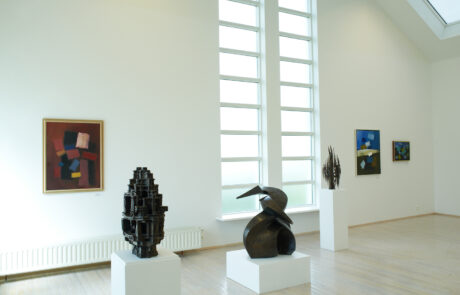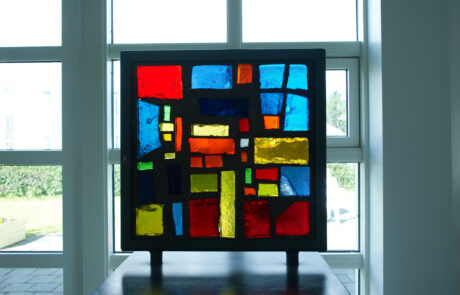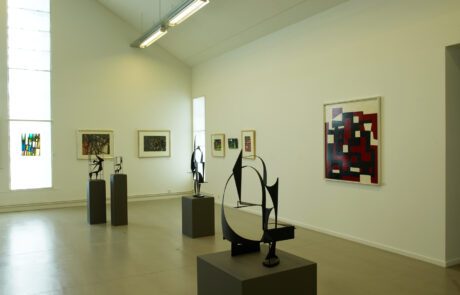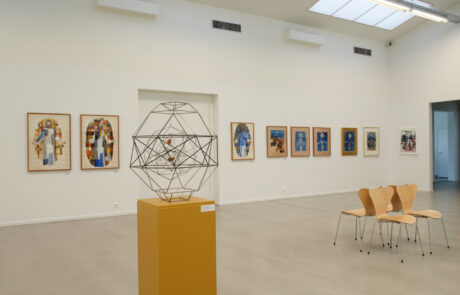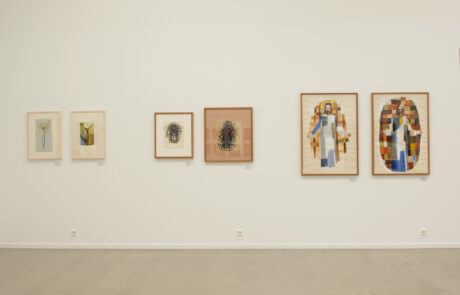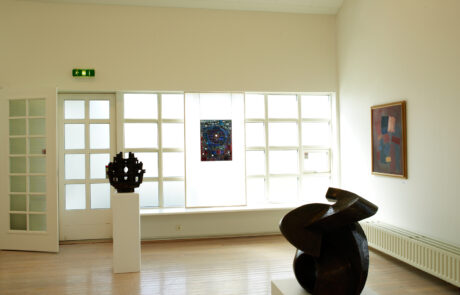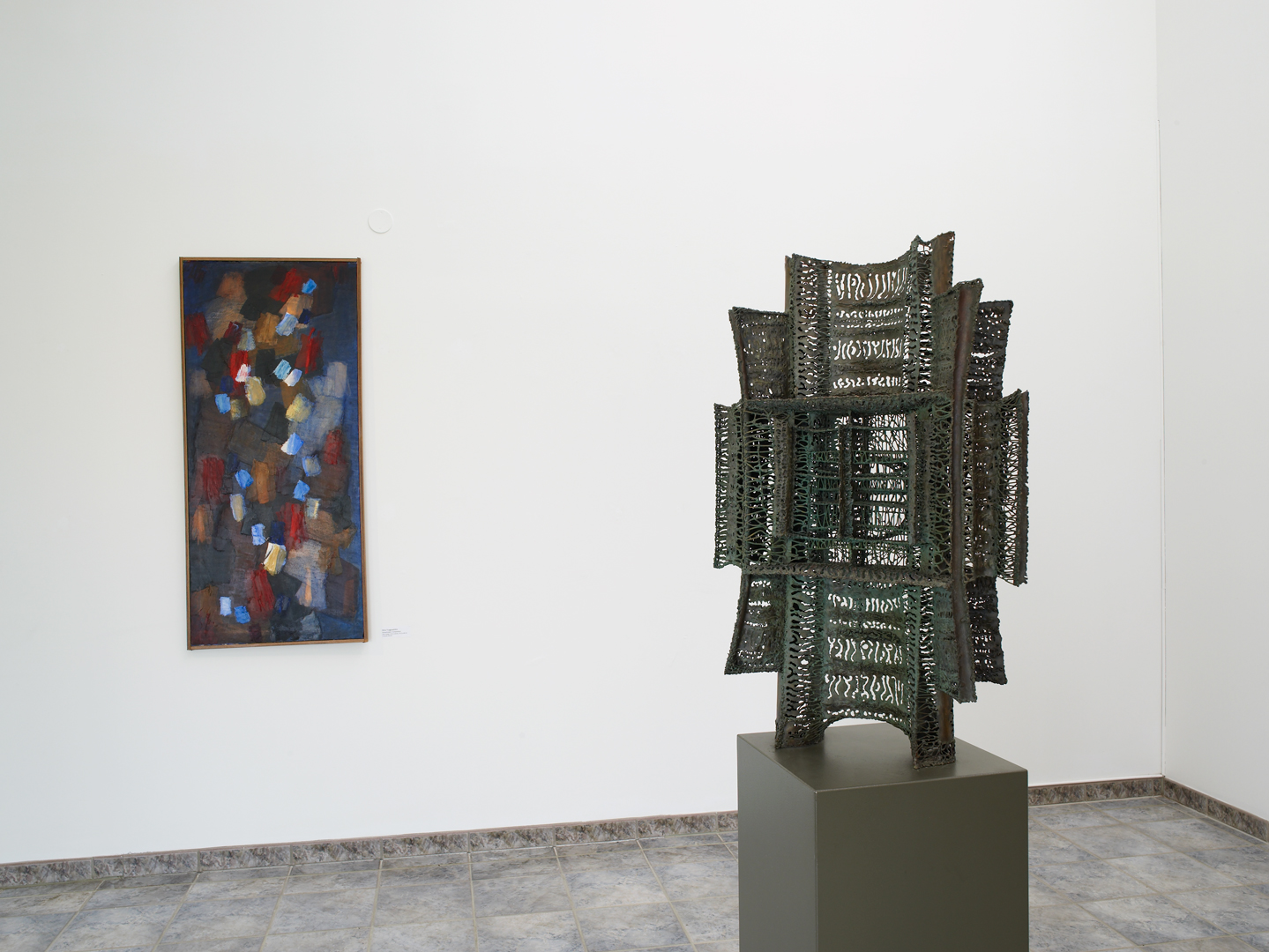
Women of the Spirit
Nína Tryggvadóttir & Gerður Helgadóttir
July 5, – September 27, 2009
Ásdís Ólafsdóttir
Skálholt Cathedral rises up, white, almost immaterial, on the bank of the Hvítá river in south Iceland. A church has stood at Skálholt since the 11th century, and a total of twelve churches and cathedrals have been built and rebuilt here. The twelfth-century cathedral of Bishop Klængur Þorsteinsson was far larger than the present building – lofty and richly ornamented, one of the largest wooden churches in Europe.¹ The little wooden church built in 1851, on the contrary, was a modest structure, without even a tower in its original form.² Skálholt thus provides insight into the history of the Icelandic nation: its golden age, its centuries of degradation, and its resurrection. In centuries past one of Iceland’s main cultural centres, Skálholt is now the site of a folk high school and a cathedral, which host a programme of concerts, courses, exhibitions and retreats. Skálholt may be seen as a spiritual haven, far enough from the hustle and bustle of everyday life, yet easily accessible.
In 1957, a competition was held for the design of stained-glass windows in the new cathedral at Skálholt, which had been designed by State Architect Hörður Bjarnason. Two Danish businessmen and art-lovers, Edward Storr and Svend Louis Foght, had undertaken to donate the windows, which were to be made by an Icelandic artist. The selection committee comprised Kristján Eldjárn (Director of the National Museum, later president of Iceland), architect Sigurður Guðmundsson, art historian Björn Th. Björnsson, Svend Møller (President of the Danish Academy of the Arts) and architect Håkon Stephensen, editor of Politiken.³ In the spring of 1958, Gerður Helgadóttir’s proposal was placed first, followed by Nína Tryggvadóttir, and in third place Sigurður Sigurðsson. The initial idea was that designs by all three artists should be used, but in due course it was decided that Gerður should make all 35 windows for the vestibule, nave, transepts and chancel. The Oidtmann company in Germany made a tender for the windows, on the initiative of Nína, who had previously worked with the company on stained glass. The windows were installed in the summer of 1959, although the cathedral was not formally consecrated until 21 July 1963.
Rhythm of the universe
I sat down, almost having lost my nerve. I noticed the pieces I’d shown at the Salon de l’art sacré, and it was as if fresh water flowed between my skull and my brain, washing away all the mess that had accumulated there. Of course I should do the windows in the same style as my iron pieces […]. I rushed around, opening all my tubes of paint, laid both sheets of paper on the floor, and after half an hour I had filled the spaces, and then I started going over it all with black.
This is Gerður’s account of the creative process of preparing for the competition, in a letter to her father.⁴ At that time she was working on sculptures made of slender iron rods, which formed an often-complex pattern of lines based on symmetrical polygons. She had trained in window-making at the Jean Barillet glass workshop in Paris in 1954, and her first stained-glass commissions were for the Grund old people’s home in Reykjavík and Hallgrímskirkja church at Saurbær, west Iceland, in 1955-7. Those windows were partly figurative, based on almost right-angled geometrical planes. In the Skálholt windows the artist often used strong centralised composition with oblique lines, strongly reminiscent of her sculptures of that period. Her technique was unusual as she painted delicate lines by hand on the panes of glass between the lead cames, shading part of the glass in order to achieve the complex network and light effects she sought. At the Oidtmann brothers’ workshop, the glass surfaces were coated with black paint, which was the mostly rubbed off when dry ; this yielded a greyish, muted lustre.⁵ The lines painted on the glass by Gerður are reminiscent of the delicate threads she added to the sculptures she showed in Paris in January 1958 ; this reinforces yet further the relationship to her sculptural works.⁶
Like Gerður’s sculptures, the Skálholt windows are largely abstract, yet they all have a specific significance, based on a deeply-considered system of ecclesiastical symbolism and number. In her preparation for the task Gerður read sagas of medieval Icelandic bishops, the Book of Icelanders, Kristni saga (which recounts the story of Iceland’s conversion to Christianity around 1000 AD) and, of course, the Bible, with which she was familiar both in Icelandic and other languages. She also used René Gilles’ book Le Symbolisme dans l’art religieux, and Commentaire de l’Évangile by Lanza del Vasto.⁷ The artist placed importance on the symbolic significance of number, and forms derived from numbers, such as the triangle, rectangle etc., up to a dodecagon (twelve-sided figure). “All numbers have their own real form. Number reigns everywhere in nature, in the symmetry of plant leaves, the rhythm of music, poetry and colour, even in the structure of atoms at the most basic level,” she wrote.⁸
The competition brief included a summary of the history of Skálholt and its bishops. Gerður opted to devote the windows on the south of the nave to five bishops: Gissur the White, Gissur Ísleifsson, Klængur Þorsteinsson, Páll Jónsson and Saint Þorlákur Þórhallsson, patron saint of Skálholt. St. Þorlákur is commemorated by the window at the chancel end of the nave, and also by the window in the west wall, above the entrance. In the north windows are symbols which apply to the bishops in the facing windows, based on certain passages of the Bible. The small windows at the top of the nave walls are mainly symbolic of the Passion of Christ, i.e. nails and hammer, scourge, pincers, crown of thorns and sponge, as well as a fish, Veronica’s Veil, a chalice and a ladder.
The north transept, in tradition dedicated to the Virgin Mary, is dedicated to Christ, and the south transept to St. Peter, to whom the cathedrals of Skálholt were dedicated. Four windows on either side of the chancel symbolise human weakness on the south, and God’s creation on the north. Gerður said that she had “chosen, on either side of the chancel, the holy of holies in the cathedral, creation and dissolution. In the human heart are both good and evil, the opposites which are constantly warring in a human being.”⁹ The small windows in the vestibule and vestry have geometrical floral designs.
As an example of the symbolism of the windows, let us consider the fourth window on the south side, dedicated to Bishop Páll Jónsson. Gerður quotes the saga, which describes the bishop’s courtesy and erudition, his versification, his writing skill and singing talents, and writes: “I have chosen the hexagon for this window, as it is the symbol of perfect balance and harmony. Refraction is multiplied in the hexagon, and this stands for the works of Bishop Páll, who was an ornament to the church in so many ways.” ¹⁰ In a letter to her father in which the artist describes Bishop Páll as “an artist in every field,” she says that the hexagon also applies to perfect harmony in music, and is “in addition, a symbol of beauty, perfection, and the rhythm of the universe.”¹¹
Although the competition brief stated that participants were “given complete freedom with respect to the style and themes of the images,” pressure was exerted on Gerður to produce figurative designs. State Architect Hörður Bjarnason was the main source of this demand, but in due course the donors, together with the Danish members of the selection committee, convinced him of the excellence of Gerður’s abstract designs. She had argued the issue for a whole year, from May 1958 to April 1959, when Hörður finally accepted her proposals, after she had explained in detail the themes and symbolism. During that time she was developing the designs, and in early April 1959 she made major changes, producing her final designs.¹² Gerður devoted enormous effort to every aspect of the windows. In her notes to Hörður she wrote: “This project has been very difficult to handle, both with respect to the location of each factor, the relationship between them, and the overall ambiance of colours.”¹³
The colour palette of the windows makes much use of primary colours – blue, red and yellow – along with white, and a little green, brown and pink. Guðbjörg Kristjánsdóttir has written that Gerður’s first sketches show that she followed the medieval French tradition of colour: predominantly blue on the north side, and red on the south.¹⁴ Gerður did not comment on the symbolism of the colours, but says in a letter about her first drafts: “The colours of the set of four windows were very like the colours of a certain sunset at home. I had never seen the sky and sea as red as they were that evening, or the mountains such a dark blue.“ ¹⁵ Gerður made extensive use of primary colours in her windows for Icelandic churches, no doubt partly in keeping with tradition, but also reflecting the interaction of the buildings with their surroundings, and the Icelandic light conditions, of which she was very aware.
Gerður’s father Helgi Pálsson composed music in his spare time, and they often discussed music. While working on the Skálholt windows, she said she had listened to “Bach’s St. John Passion, the Requiem […] by Mozart, Gregorian chant, various records of music by Pergolese, Corelli and Tartini, songs from masses in the Orthodox church in Paris [… and] old songs from Jerusalem.”¹⁶ She also looked for Muslim and Buddhist temple music, but without success. “I did it in order to find out whether these windows would work in temples or churches of any religion.”¹⁷ This illustrates Gerður’s open-mindedness about religion and the spiritual. She was familiar with Christianity, and eagerly explored its history, mysteries and semiotics, but nonetheless respected other religions, which she felt were equally valid. At that time she was also attending classes in mysticism, as will be discussed further below.
Ethereal Christ
Hörður Bjarnason approached Nína Tryggvadóttir in December 1961, to make a mosaic mural for the chancel wall of Skálholt Cathedral. From the start the theme was to be Christ. In a letter in early 1963, Bishop Sigurbjörn Einarsson wrote that, to him, the theme of “Christ the King is an image which expresses, through the magic lantern of art, the presence of the invisible king, to whom Christianity bears allegiance.” He also asks the artist for “a part of [her] rich soul, for the sacred stone that stands on the most precious earth of Iceland.”¹⁸
The mosaic was installed in June 1966. During the four-year period Nína worked through many sketches and drawings, until the final version was completed in the autumn of 1965. Some designs show the crucified Christ as emaciated, resembling the figures of Giacometti, suffering, with bowed head.¹⁹ Others depict him as more kingly – even a Viking warrior king, wearing robe and crown with black rays, reminiscent of the lead cames of stained glass. Here we see the figure of Christ, viewed from the front with arms extended. In a series of watercolours, Christ is seen within an oval form which reaches down to the knees, with a strongly-formed halo in the Byzantine style. Two colourful oil paintings are studies for the head of Christ, seen slightly sideways. Nína also made large designs depicting Christ within an oval shape, divided into coloured sections, some of which overlap the clothes of Christ. On the drawings of the cathedral sent to the artist, the altarpiece was indicated by an oval shape, and this probably influenced her drawings.
In the final series of images the outlines of Christ are drawn in black, then painted over with blue acrylic paint, which almost fills the rectangular sheet of paper. Initially the lines are strong, and they gradually grow more delicate and the figure more ethereal. The face progresses from solemnity to an exalted gentleness, reminiscent of oriental figures. Finally, Nína decided to use earth tones in the background, as if to establish a link between the figure of Christ and the earth; more specifically, Icelandic earth. She wrote in early 1965: “I feel that this image, which signifies Christ appearing as a sort of spirit in an (Icelandic) landscape, will become most beautiful on the wall. The idea is that the image of Christ, unclear, or almost ethereal, appears in a summer landscape, and I think it will be better than any image with firm forms.“²⁰ The Bishop replies that he feels it is right to imbue the drawing of Christ with “a certain unreality and intangibility,” and also to fit him into a setting that resembles Icelandic landscape. “But that too must be outside the limits of the tangible, so that the mind may imagine something else, something more than the eyes see.”²¹ As witness these delightful letters, Nína and Bishop Sigurbjörn were in harmony during the process of development: he understood what she was doing, and urged her not to be too material.
The final drawing was drawn with acrylic paints on a sheet of paper about 60 x 45.5 cm.²² At the Oidtmann workshop in Linnich it was enlarged to full size, 5.80 x 3.50 m. In order to maintain the proportions, the image had to be extended at top and bottom. This made the shape more oval, whereas the original was more-or-less rectangular. By this time Nína had moved back to New York; the Oidtmann brothers sent her pictures of the progress of the project. The mosaic was sent to Iceland in mid-May 1966, and in early June Nína made some adjustments in situ to the face, hands and robe. According to her daughter Una Dóra, who spent some days there with her, she made the face more ethereal, and the hands more expressive, and stronger.²³
It has been suggested that Erlendur of Unuhús, a lover of art and poetry, may have been the model for the figure of Christ.²⁴ I am of the view that Nína’s idea was less specific and more universal, as witness the fact that the facial features are mostly blurred, and blend into the background. The mosaic technique imitates the brushstrokes of the acrylic image, while at the same time the chancel wall seems to open up to show a landscape and the ethereal image of Christ, beyond the limits of the building. The palette of the image is muted, in tones of blue, brown, green and pink, in clear contrast to the strong primary colours of the windows. Nína did not attempt to adapt her work to the existing stained glass; instead she created an autonomous work of art on her own terms: her vision of “the transcendent and at the same time Icelandic Saviour of Skálholt,” to quote Nobel-prizewinning author Halldór Laxness.²⁵
Under one roof
Gerður Helgadóttir and Nína Tryggvadóttir were artists who expressed themselves through many different media. Gerður the sculptor was also an artist in collage, gouache and mosaic, as well as designing furniture, jewellery and ecclesiastical objects, and painting windows in nine churches in Iceland and Germany. Nína the painter made collages, children’s books, photographs and mosaics, designed textiles and costumes, and worked in glass from 1953, for such buildings as the National Museum of Iceland, the University of Iceland chapel and churches in Germany.
Both artists lived abroad for much of their lives, and were leading artists of their day. But they did not loose contact with Iceland; they were keen to produce works for their native country, although this was invariably badly paid, in that time of currency restrictions, and they often had to wait years for final decisions and commissions. “It would mean a lot to me to undertake this work,” Nine reiterated twice in a letter about the Skálholt mural.²⁶
Although they were different in many ways, and not of the same generation – Nína was 15 years older than Gerður – both were determined and devoted artists. Both died before their time, Gerður aged 47 and Nína 55, but left behind them an oeuvre which would do credit to the most energetic of artists. It was a unique event that these two inspired artists should be brought together in Skálholt Cathedral, each on her own terms and with her own personality traits. Their works imbue this ancient cultural centre with an atmosphere of spirituality, and reverence for the place and the subject; at the same time, there was no compromising of artistic standards or modern creativity.
In Paris
Nína and Gerður were both in Paris in 1952-7. Gerður moved there from Florence in 1949, and in due course Nína arrived in the city on the Seine after being refused a residence permit in the USA, where she had lived since 1943. At that time of vibrant artistic creativity and debate, their art was shaped among a group where abstraction was the rule. Both developed their own geometrical imagery: Gerður in Cubist sculpture and black metal sculptures (the first Icelandic artist to do so), and Nína in dense paintings and small pictures, which resemble her stained-glass works; in these black shapes and lines echo Gerður’s metal shapes. It was at this time that both artists became interested in coloured glass, no doubt under the influence og their French environment; a revival in ecclesiastical art was taking place among modern artist.
Around 1955 Nína’s forms started to escape the bounds of the framework: they seem to take flight, heralding the lyrical expressionist method which would characterise her work. At that time Gerður was working on delicate symmetrical metal sculptures of iron wire; after 1958 she started to work in bronze, and developed a more sophisticated form of expression, in which rugged forms open into the space. In the case of both artists, their art became more spontaneus, with a stronger element of nature, in the 1960s.
Spiritual growth
Although Gerður and Nína made works for churches and were familiar with Christianity and its motifs, both were open-minded about other religions. Spiritual quest may be said to be an important aspect of their art, but the influence of this is more obvious in their later works.
From 1953 until her death Gerður attended lessons given by Jeanne de Salzmann, a Swiss dancer and former pupil of Georgian mystic G.I. Gurdjieff (1877-1949), who sought to awaken people from spiritual sleep, for instance by confronting their reflexes and indoctrination. With Salzmann Gerður practised various physical and mental exercises, including “sacred dances” based on coordinated movements and geometrical rhythm.²⁷ Gerður also practised judo under the guidance of artist Yves Klein, who lived in the same building for a time; she made a sword-hilt for him when he was admitted to the Ordre des Chevaliers de Saint Sébastien. She was commissioned to make a crucifix by the godmother of Irina Brook, daughter of director Peter Brook, who made a documentary on the life of Gurdjieff. Gerður was also keenly interested in astrology, and asked her father to send her books on the subject, such as The Inhabited Universe.²⁸
Paramahansa Yogananda, etc., in exchange for books by Gurdjieff and his disciple Ouspensky²⁹ In the mid-1950s Gerður made wire sculptures with a strong cosmic element, as witness titles such as Festing/Firmament (1956). In these works she made use of pieces of glass, which “float” within a symmetrical space. The bronze Nafli/Navel resembles a planetary system, and Orgelfúga/Organ Fugue (1960) extends bronze arms to the sky. In 1966, pursuing an old dream, Gerður went to Egypt. On her return she made bas-reliefs and sculptures in concrete, often inlaid with glass and abstract hieroglyphics. The ancient theme of the “All-Seeing Eye” is ubiquitous in her work at this time, for instance in her proposals for an altarpiece for Kópavogur Church. In the last years of her life the artist worked in simple plaster forms, returning to symmetricality around a central space, and perpetual movement, which was a crucial aspect of Gurdjieff’s meditation technique.
When Nína Tryggvadóttir was in London in 1958 she met a Japanese Zen master and art historian, Hoseki Hisamatsu, who would be an influence upon her.³⁰ In the early 1906s she twice visited Japan with her husband Alcopley, and learned about Zen first-hand. Alcopley painted pictures strongly reflecting Oriental calligraphy, but the influence is less obvious in his wife’s work. The Zen influence is manifested more in the calm and reflective mood of her late works. At that time, after about 1963, her style grew milder: forms which had been translucent and scratchy became indistinct and shadowy, as the brush replaced the palette knife. The explosion of energy and colour which typified her work after her return to New York in 1959 gave way to a reflective, gentler approach, and darker, more muted colours.
In 1967 Nína wrote an article, Painting With Light Through Colored Glass, which was published the following year in the periodical Leonardo.³¹
She writes:
It seems to me that in our time rooms containing illuminated glass paintings are much needed for providing a place for mental relaxation, concentration and the pleasure of visual experience. There are many occasions in our lives today when we would like to shut out the outside world for a while and to occupy our minds in a more serene, relaxing environment. Such rooms could be installed in museums or as reception halls in large buildings or even as part of a private home.³²
Although Nína refers here to glass art, the wish she expresses may also be applied to her later paintings. The presence of one such work in a space is sufficient to create an atmosphere of mental relaxation and concentration. Like Gerður’s sculptures, Nína’s paintings are evidence of a fully-mature artist who is at peace, knowing that she and her art are an indissoluble part of a perfect cosmic balance.
Curator: Ásdís Ólafsdóttir
Ásdís Ólafsdóttir is an art historian resident in Paris. She graduated with a doctorate from the University of Paris Panthéon-Sorbonne in 1995. She has published widely about design, architecture and modern art, and she is a contributor to the new History of Icelandic Art to be published by the National Gallery of Iceland and the Forlagið publishing house. Ásdís has worked on exhibitions, and selected the exhibits for Sýn/Vision at Maison Européenne de la Photographie in Paris 2004. She is administrator of the Maison Louis Carré, designed by Alvar Aalto, in Bazoches, France, and editor of the periodical ARTnord.
Nína Tryggvadóttir 1913-68
Nína (full name Jónína) was born on 16 March 1913 in Seyðisfjörður, east Iceland, the daughter of merchant Tryggvi Guðmundsson and seamstress Gunndóra Benjamínsdóttir. At the age of seven she moved to Reykjavík. In 1932 she studied art with painter Ásgrímur Jónsson, and in 1933-34 at the art school of painters Finnur Jónsson and Jóhann Briem. In 1935 Nína went to Copenhagen to study at the Royal Academy of Art. In 1939 she was in Paris, before returning home to Iceland, where she became familiar with the Unuhús artistic coterie. In 1943-6 she studied at the Art Students League í New York, and mingled with up-and-coming US artists. She married Alfred L. Copley in 1949, and their daughter Una Dóra was born in 1951. The family moved to Paris in 1952, to London in 1957, and in 1959 back to New York, where Nína lived for the rest of her life. She worked in stained glass from 1953, making widows for churches, the National Museum of Iceland, and private purchasers, in collaboration with the Oidtmann brothers in Linnich, Germany. In 1961 she was commissioned to make a mosaic mural for Skálholt Cathedral, which was installed in the summer of 1966. Nína died of cancer on 18 June 1968 in New York. She was 55.
Gerður Helgadóttir 1928-75
Gerður was born on 11 April 1928 in Norðfjörður, east Iceland, the daughter of Helgi Pálsson, manager of the local co-operative and a composer, and Sigríður Erlendsdóttir. At the age of nine she moved to Reykjavík. In 1945-7 she studied at the College of Crafts, and was taught by sculptor Sigurjón Ólafsson. In 1947-49 she studied sculpture at the Accademia di Belle Arti in Florence. In 1949 Gerður went to Paris, where she studied first at the Académie de la Grande Chaumière and then in the private school of sculptor Ossip Zadkine. In the 1950s she showed her work regularly in Paris galleries, and mixed with an international community of artists. In 1954 she learned how to make glass windows at the workshop of Jean Barillet in Paris, and in 1958 she was awarded first prize in a competition to design windows for Skálholt Cathedral. These were installed in 1959. In the following years she made many more windows and mosaics, working with the Oidtmann brothers in Linnich. Gerður moved to the Netherlands in 1970, but returned to France two years later. She died of cancer in Iceland on 17 May 1975, aged 47.
Skálholt – slide show
Salbjörg Rita Jónsdóttir is a visual worker. She studied industrial design and anthropology in Iceland, and Mediengestaltung (Media Art and Design) at Bauhaus Universität in Weimar, Germany. She works at the H:N advertising agency as a graphic designer, and has also worked independently in photography, theatre, and other visual works.


